POST - 1881 LAND LINE TELEGRAPH EQUIPMENT (PART II)
W1TP TELEGRAPH AND SCIENTIFIC INSTRUMENT MUSEUMS: http://w1tp.com
PLEASE **WAIT** FOR ALL PICTURES TO LOAD !
(If some do not load, click "Reload Page".)
- Click BACK to Return to the Pevious Page.
EARLY LAND-LINE TELEGRAPH EQUIPMENT (2): Approximately 1890s-1960s
(1501-3000)
EARLY STEEL LEVER KEYS (2): (Approximately 1890s-1960s (1501-3000)
After the Civil War, Railroads, Telegraph Companies, and Businesses
provided a growing market for the many types of apparatus being produced.
Attempts to avoid patent infringement led to new and interesting designs.
KEYS (1001-1500), KEYS & SOUNDERS (1501-2000), SOUNDERS (2001-2500),
REGISTERS, RELAYS, & OTHER (2501-3000)
(The instruments are in approximate chronological order: Oldest first.)
* = (Items no longer owned.) ** = (Items in other collections.)
Click Here for Part I:
Part II:
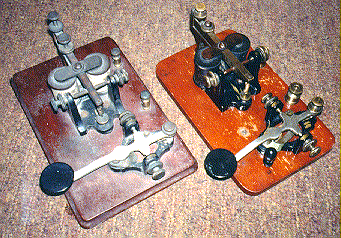
1505 STEEL LEVER KEY KOB:(60KB)
Made just after the camelback era. Has no spring adjusting screw.
Cast iron base key with shorting switch engraved J.H.Bunnell & Co New
York. Arm engraved "Patented Feb 15, 1881". Mounted on wooden base
with J.H.Bunnell & Co, New York USA 20 ohm sounder.

1507 STEEL LEVER KEY KOB:(41KB) As above but
has no stamping on key or sounder.

1508 STEEL LEVER KEY KOB:(45KB) As above but
has no stamping on key or sounder.

1520 UNUSUAL PROTOTYPE/EXPERIMENTAL ALUMINUM-LEVER KEY
KOB:(10KB) This is a classic early Bunnell KOB with an unusual
ALUMINUM KEY LEVER. I believe that this lever was made by the
Bunnell Company in an attempt to study the advisability of
making Aluminum-Lever Keys. They could have thought that the
lighter-weight Aluminum might give a potentially faster action.
There is an old-style steel trunnion pin press fit into the Aluminum lever
which leads me to believe that this is an early experimental key. The
press-fit steel trunnion pin was abandonned when the all steel
lever triumph key was invented in 1881. The steel trunnion pin
was known to come loose with extended use and it would then allow
the key lever to slide left and right making the key useless.

1540 J.H.BUNNELL "COMMEMORATIVE MINIATURE SOUNDER:(12KB)
This unique and fully functional Bunnell Miniature Sounder was
presented to each of the guests at a dinner in honor of Andrew
Carnegie in 1908. The dinner was held to celebrate his "73rd"
birthday and was attended by hundreds of important people including
Thomas Edison and many members of the Civil War Military Telegraph
Corps including four members who had actually received his call for
volunteers over the telegraph lines in 1861. The dinner concluded
with the singing of "Auld Lang Sine" by Samuel Morse's Grandaughter.

A special brass plaque:(9KB)
on the bottom of the sounder reads: TELEGRAPHER'S DINNER in honor of
ANDREW CARNEGIE, Hotel Manhattan, New York, November 27, 1908.
The plaque also has a big "73" engraved on it over the other writing.
It was reported that each guest had one of these sounders at his place
setting and that the host sent messages to his guests' sounders in
code.

1550 J.H.BUNNELL MINIATURE KEY and 1551 SOUNDER:(60KB)
This is the tiny brass Bunnell miniature key with the ring for
attaching it to a watch chain. The steel lever is stamped
J.H.Bunnell, N.Y. Oval brass base measures 1" long. These keys
are fully functional and were sold either plain or with a ring or
pin. It is mounted on a small wooden board with the #1551 sounder.
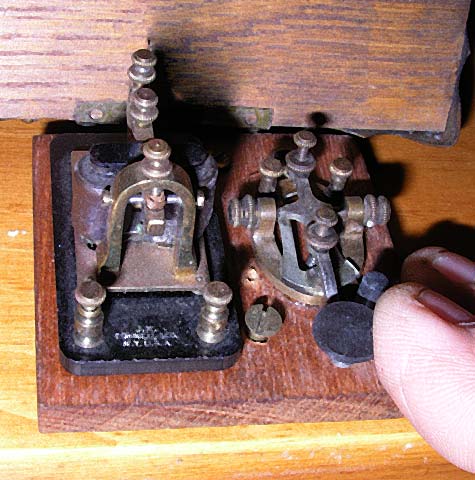
1550a Another view of the J.H.BUNNELL MINIATURE KEY and
SOUNDER:(48KB)
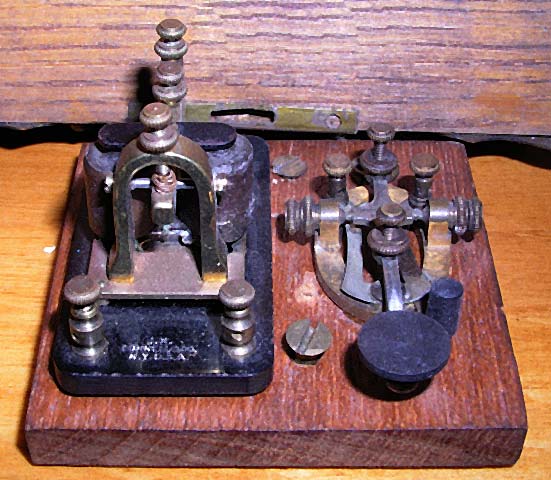
1550b Another view of the J.H.BUNNELL MINIATURE KEY and
SOUNDER:(57KB)
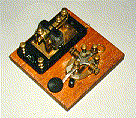
1550.gif J.H.BUNNELL MINIATURE KEY and 1551
SOUNDER:(11KB)

1551 J.H.BUNNELL MINIATURE
KEY:(34KB) This is the tiny Bunnell key with the ring for attaching it to a
watch chain.
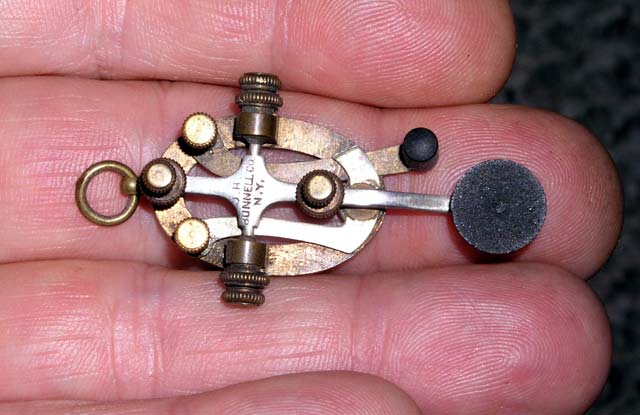
1551a Another view of the Bunnell
Miniature Key:(38KB)

1552 J.H.BUNNELL MINIATURE KEY AND
SOUNDER:(44KB)This is the tiny Bunnell Miniature Key and Miniature
Sounder with 1-1/8 inch long brass base mounted on a black base stamped
J.H.Bunnell & CO. New York, USA. It is fully functional.
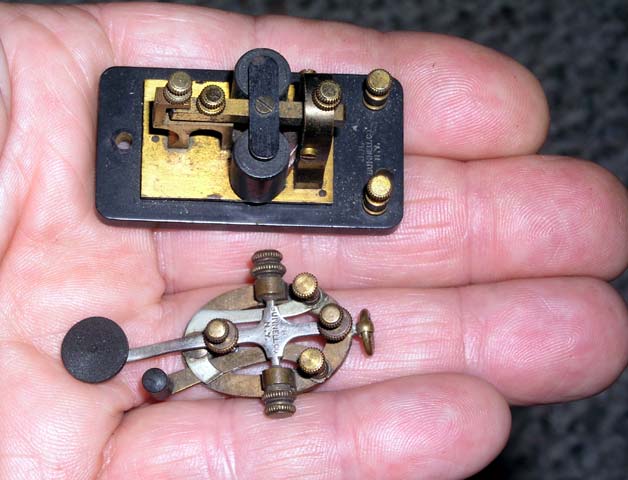
1552a Another view of the Bunnell
Miniature Key and Sounder:(43KB)

1553 J.H.BUNNELL MINIATURE SOUNDER:(34KB) This is the
tiny Bunnell Miniature Sounder. It is fully functional and all adjustments
work.
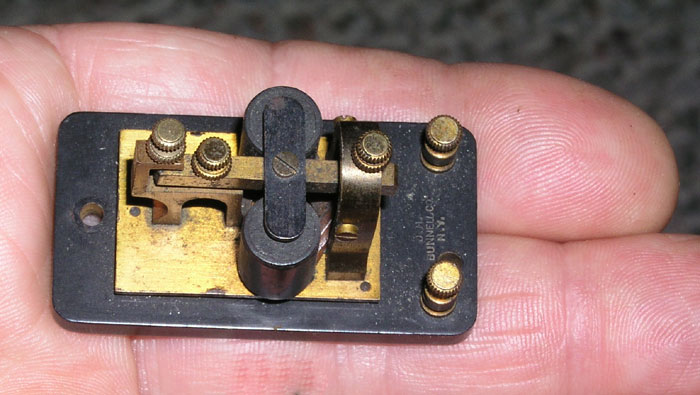
1553a Another view of the Bunnell Miniature
Sounder:(38KB)

1555 ** NEW MANUFACTURE BUNNELL MINIATURE KEY &
SOUNDER:(37KB)This miniature Bunnell KOB is being offered by
Dr. Joe Jacobs who is now the owner of the J.H.Bunnell Co.
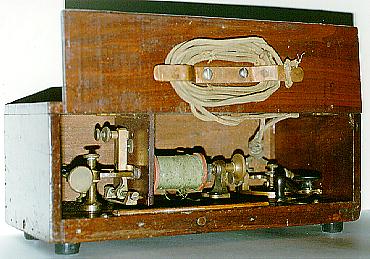
1575 * BUNNELL "Trainmaster" PORTABLE
RESONATOR-BOXED KEY & SOUNDER:(31KB)
This unique portable telegraph set consists of a resonator box with a handle
and a brass "BUNNELL 160 OHMS" label on top, an unboxed box sounder, and
a modified Bunnell steel-lever key.

The closed box looks like this:(31KB)
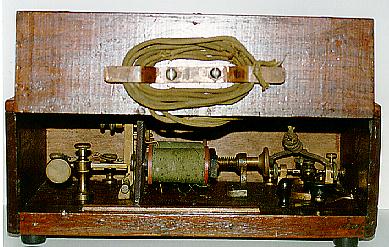
Another view of the inside:(34KB)
showing the steel-lever Bunnell key on the right, and the unboxed
box-sounder on the left as well as a place to coil the wires in the cover.
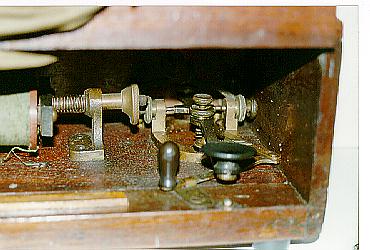
The key has an unique additional bar
riveted to the shorting bar:(25KB)
That allows the shorting bar to be operated from the left side of the key.
This is necessary because of the restricted space inside of the box.
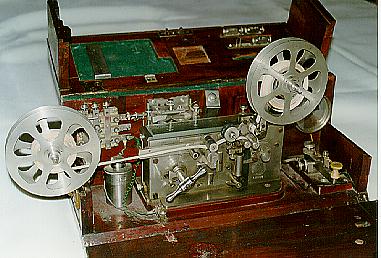
1700 WESTERN ELECTRIC-MILANO PORTABLE BOXED
REGISTER, KEY, SOUNDER, METER, BELL, SWITCHBOARD ETC:(25KB)
This is a complete ink-writing portable telegraph set consisting of
a miniature ink register with folding paper tape reels, an Italian style
telegraph key with Ivory knob, an unique sounder that rings a bell, a
plug-style switchboard, and ink well, an ink applicator, with fitted pliers
and accessories for field use.

The 8" x 7" x 20" brass edged wooden box:(22KB)
has brass reinforcements around all edges. A brass label in the center
reads 284. Another brass tag in the front left reads MATR 92 21-72.
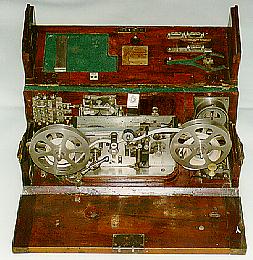
This view shows the register with
its arms folded:(34KB)
The set is obviously designed for field use with all metal parts plated.
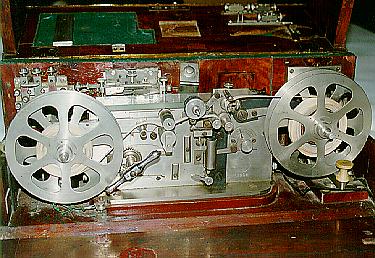
This close-up view shows the ink register:(31KB)
which is stamped WESTERN ELECTRIC ITALIANA-MILANO. Telephonici-telegrafici
Societa anonyma. Number 15998.
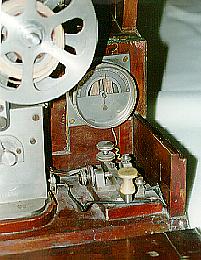
This close-up view shows the early telegraph
key:(19KB)
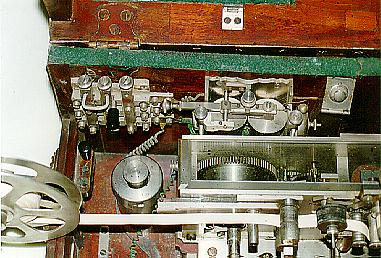
This close-up view shows the sounder/bell
and switchboard:(42KB)

1720 TWO CLASSIC GERMAN SIEMENS KEY-REGISTER
SETS:(28KB)These sets were the most widely used telegraph
stations in Europe. They were found in every town telegraph
office across the continent. They consist of a telegraph key, ink-writing
register, and galvanometer which measured the electrical condition of
the telegraph line. A roll of paper tape is stored in a
special drawer in the wooden base. Ink writing registers were required
because it was illegal to copy Morse Code by ear since that method
was not thought to be reliable.
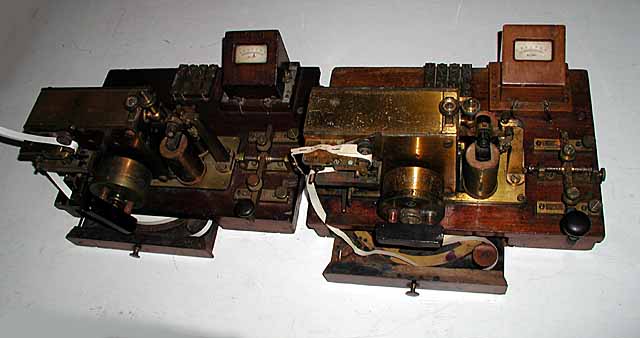
1720a Another view of the two sets:(30KB)

1730 * BRITISH SIEMENS BROTHERS KEY-REGISTER SET
WITH UNIQUE SOUNDER-OPERATED REGISTER:(18KB)
This interesting set is typical of those used throughout Europe where
copy-by-ear using sounders was not trusted. The set is labeled: Siemens
Brothers & Co. London. No. 17022. and there is a tag on the unique
sounder mechanism which reads: A. E. Co. Ltd. A.T.M. Liverpool.
A roll of paper tape is stored in a drawer under the register.
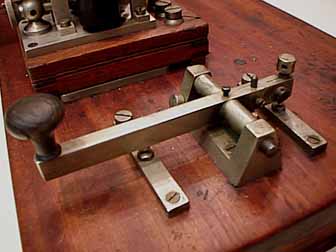
The key:(16KB) is a typical straight-lever
European style key.
The ink-writing register is operated by an
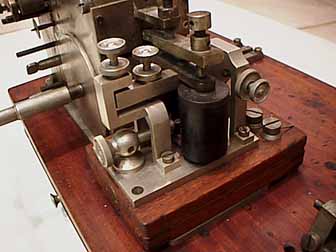
Unique Sounder Mechanism:(19KB) which is directly coupled
to the Register mechanism.

1745 CZECH REGISTER PROBABLY MADE BY SIEMENS:
(26KB) The Siemens company of Germany made most of the registers
used in European telegraph offices.
Some of these registers were labeled with other names.
This one carries CZECH identification marks which read:
FRANTISEK, STEPANEK, & SPOL, V SPOLECNOST S.R.O, v PARDUBICCICH and the
number 195. Pardubice is a town in eastern Bohemia that was part of the
Austrian Monarchy, later a part of Czechoslovakia and now in CZECHIA (the
Czech Republic).
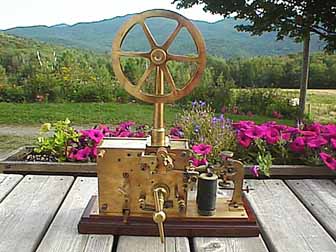
1745a Another view of the Russian Register:
(26KB)
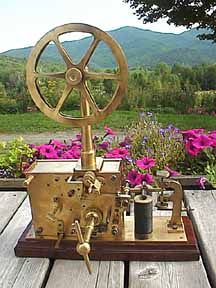
1745b Another view of the Russian Register:
(26KB)
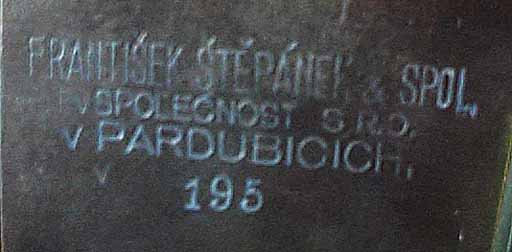
1745c A view of the Russian Register which shows the
makers name:(26KB)

1747 AUSTRIAN EMBOSSING TELEGRAPH
REGISTER: (26KB) This is an early Embossing Telegraph Register made in
Vienna, Austria. It is marked: CZEIJA NISSL, WIEN, 769. Embossing registers
recorded dots and dashes on a moving paper tape by pressing a sharp point into
the tape. The sharp point 'embossed' a depression into the paper tape.
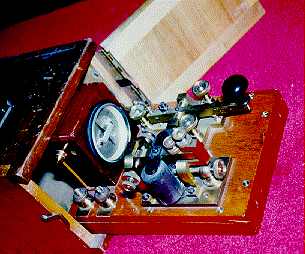
1755 BRITISH GPO KEY-SOUNDER-GALVANOMETER:(40KB)
Huge all brass key Engraved M.W.T.Co. Ltd. 372. 1915, and sounder
engraved G.P.O.16830 and Galvanometer Engraved EDISON & SWAN,
No. 18220. 1917, mounted on wooden base and fitted into wooden
box with brass handle.
Historian and collector Neal McEwen K5RW has researched this unit
and reports that it is properly called a 'direct working
single current intermediate baseboard set.' He traced out the
schematic and found that the sounder is in the circuit only
on receive. The sounder is out of the circuit on send. The
telegraphist apparently watched the galvanometer or listened to
the galvanometer needle ring as the needle hit the stops to
monitor his sending. The galvanometer is in the circuit on
both send and receive so the telegraphist can see the
galvanometer even if the sounder is mal-adjusted.
Neal believes that the galvanometer started out as a traditional
''Q and I'' detector, which is an application of galvanometer
technology for linemen to check bateries, find faults, etc. It
measures relative current, not absolute current. The Q and I
detectors were turned into galvanometers for use on the baseboard sets.
On Neal's galvanometer he can see the original Q and I connections
that have been puttied up.
Neal believes that these sets were made for the British Army
and that the traditional single current galvanometer was too big
to make the set portable. Hence the small galvanometer made from
the Q & I meter.
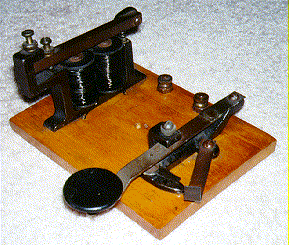
1810 * ADAMS-MORGAN (AMCO) KEY & SOUNDER
ON BASE (KOB):(35KB)
This small and simple practice set was described in a book of
do-it-yourself projects. It is surprising to see one that was
commercially manufactured with the letters AMCO enclosed in a diamond
outline stamped on the base. The key and sounder are very simple but
the unusual sounder has its two coils lined up under the armiture.>>W2PM

1825 * "MOTLEY" TELEGRAPH KEY AND SOUNDER ON BASE
(KOB):(22KB)
This brass KOB carries
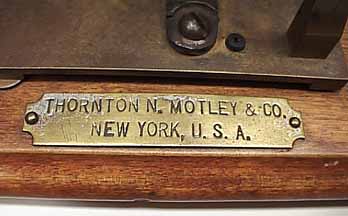
a label:(18KB)that reads:
THORNTON N. MOTLEY & CO., NEW YORK, U.S.A.
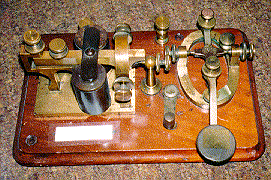
1830 * TELEGRAPH KEY AND SOUNDER ON BASE (KOB):(36KB)
Early brass key and sounder on wooden base Key and sounder stamped
J.H.Bunnell & Co., New York. Key stamped Patented Feb 15, 1881 on steel
lever. Sounder is old horizontal spring design. Has brass switch lever
on base.
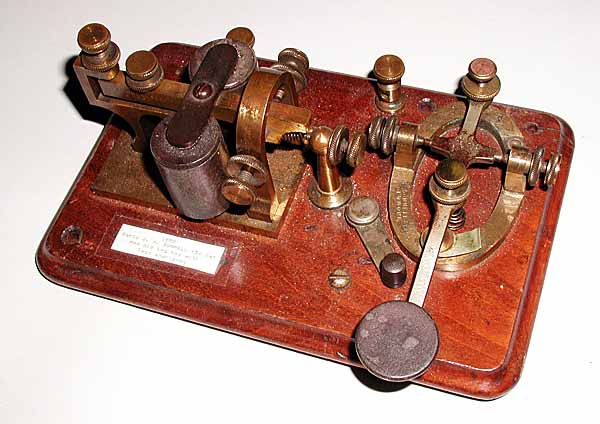
1830a Another view of the KOB:(45KB)
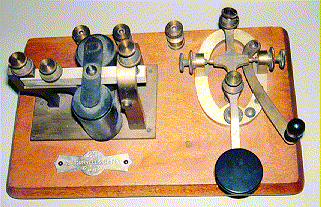
1832 * Same as above:(40KB)
with vertical spring sounder w/aluminum armiture. No switch.
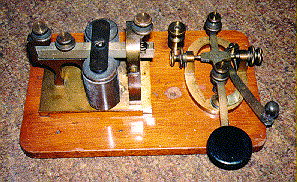
1834 * Similar to above:(39KB)
but key stamped "MESCO". No ID on sounder. Has switch.

1836 VERY PRETTY BUNNELL KEY AND SOUNDER ON BASE
(KOB):(38KB)This is an unusually attractive and clean Bunnell
KOB with 20-ohm sounder.
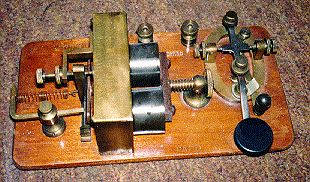
1838 * TELEGRAPH KEY AND ''SNARE-DRUM''
SOUNDER ON BASE (KOB):(42KB)
Early brass hardware key with black cast base, steel lever and shorting
switch on a wooden base. Sounder is early "Snare-Drum" style. Base
stamped J.H.Bunnell Type 220, 35-Ohms.

1839 * TELEGRAPH KEY AND ''SNARE-DRUM''
SOUNDER ON BASE (KOB):(17KB)
Similar to 1838 above.
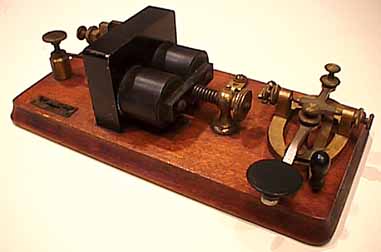
1839a Another view of the Snare-Drum set:(15KB)
1840 * TELEGRAPH KEY AND SOUNDER ON BASE (KOB): Early brass hardware key
with black cast base and steel lever and shorting switch on a wooden base.
Sounder stamped J.H.Bunnell & Co, New York U.S.A.
1842 * Same as 1840 above.
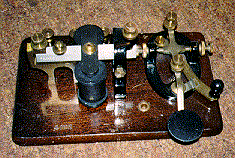
1844 * Same as above:(27KB
but sounder stamped "Manhattan Electric Supply Co.New York".
1846 Same as above but sounder stamped "MESCO".
1848 Same as above but key & sounder stamped"Signal Electric
Co.Menominee,Mich".

1849 Same as above but unmarked:(46KB)
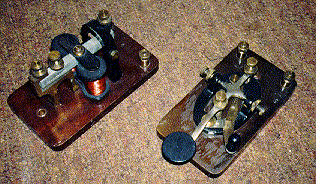
1850 * Same as above:(40KB)
but key and sounder both mounted on individual wooden
bases and stamped "Signal Electric Mfg. Co., Menominee, Mich".
1852 * Same as above but key only on its wooden base and not stamped.
1854 * Same as above but key only on wooden base & not stamped.No shortg
switch.

1860 * SKIRROW-POSTAL TEL CO KEY AND SOUNDER ON
BASE (KOB):(20KB)
Very early steel lever brass key and unique diagonal-frame
magnetic-flux-adjustable sounder on wooden base stamped
"Postal Tel Co. 150 ohm. Number 1428. SKIRROW PAT Dec. 10, 1901.
(Postal Telegraph Company owned the "Skirrow" patent which involved
the use of a rack-and-pinnion mechanism to adjust the coil-to-armiture
distance to allow the sounder to be made more or less sensitive to
the tiny currents on long telegraph lines.
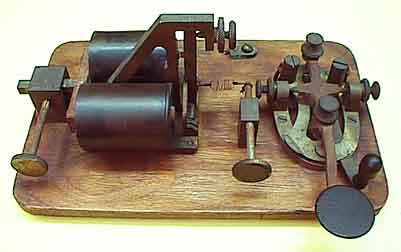
1860A * SKIRROW-POSTAL KOB:(16KB) similar to 1860.
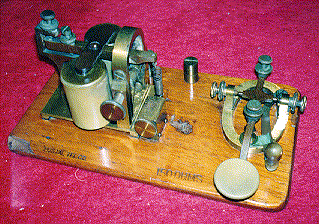
1861 * POSTAL TEL CO KEY AND SOUNDER ON BASE (KOB).(48KB)
Vy early steel-lever brass Bunnell key & Large Bunnell main-line sounder
with the unique cam operated magnetic flux adjustment mechanism.
Base stamped: "POSTAL TEL CO. 150 OHMS.
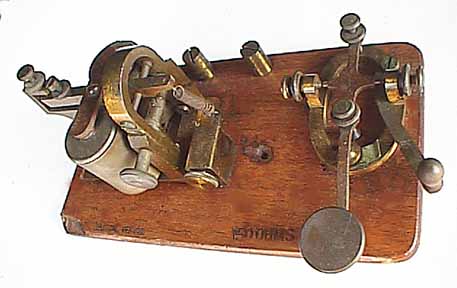
1861a Another view of the Skirrow-Postal KOB:(22KB)
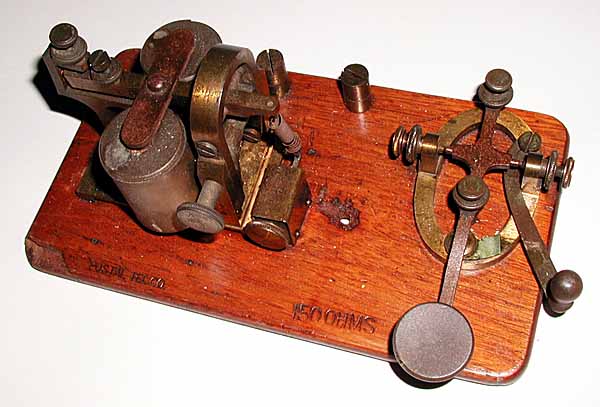
1861b Another view of the Skirrow-Postal KOB:(42KB)
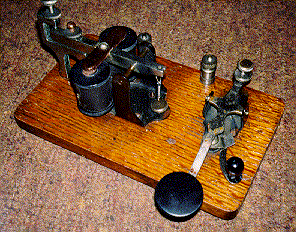
1862 * BEEKO-LIKE LEARNER'S KOB SET:(47KB)
Interesting early set with chromed key lever without spring adjusting
screw held in bent sheet metal base. Has chromed shorting switch that
looks a little like a McElroy design. The sounder has a sheet metal
base but chromed lever and anvil. Oak base.
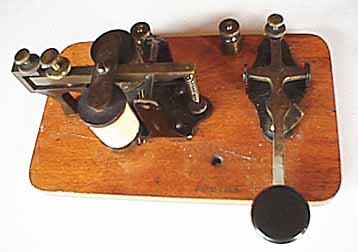
1862a Another view of the Beeko-Like KOB Set:(15KB)

1863 * BEEKO SEPARATE COMPONENT KEY AND SOUNDER
SET:(18KB)
Typical key and sounder set. The key is mounted on a separate wooden
base and has a steel key lever and no spring adjusting screw. The
lever is supported by a bent sheet metal base. The sounder also has
a sheet metal base. Many thousands of these sets were produced butg
they were so toy-like that most were eventually thrown out making
it more difficult for collectors to find them.
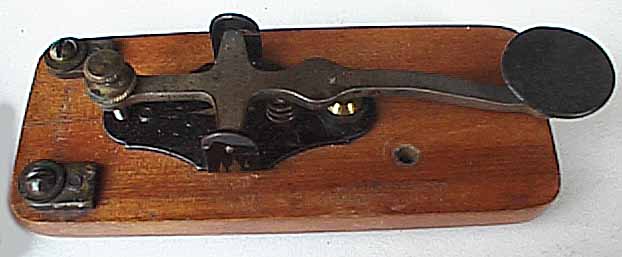
1863a A view of the Beeko key alone:(21KB)
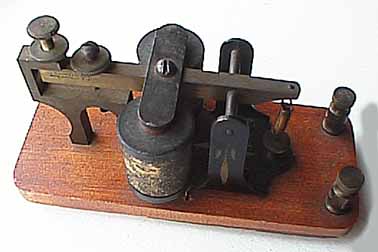
1863b A view of the Beeko sounder alone:(16KB)
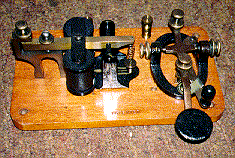
1864 * TELEGRAPH KEY AND BEEKO SOUNDER ON BASE
(KOB):(27KB)
Early brass hardware key with black cast base and steel lever and
shorting switch on a wooden base. Sounder has very simple design with no
bearing adjustments and sheet metal frame. It is stamped J.H.Bunnell &
Co, New York U.S.A.
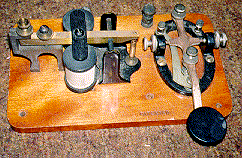
1866 * Same as above:(28KB)

1865 BEEKO TELEGRAPH KEY AND SOUNDER ON BASE
(KOB):(42KB)This is the classic BEEKO practice set made by
Bunnell. Both the key and the sounder have simple sheet metal
frames making this set very inexpensive to produce and sell.
1868 * SIGNAL ELECTRIC CO. KOB SET: All-brass key with steel lever
& Signal Electric Co. style sounder with armiture simply
stamped"MENOMINEE".
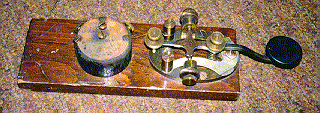
1870 * TELEGRAPH KEY AND BUZZER ON BASE:(27KB)
Very early brass hardware key with steel lever mounted on a wooden base
with a very early wood encased buzzer.
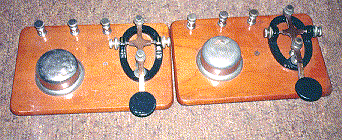
1872 * TELEGRAPH KEY AND BUZZER ON BASE:(32KB)
Brass hardware, steel lever key with black cast iron base mounted on a
wooden base with a round chrome buzzer.
1874 * Same as above.
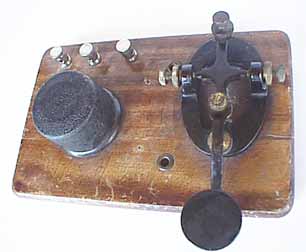
1875 * TELEGRAPH KEY AND BUZZER ON BASE:(13KB)
Similar to 1872.
1876 * Same as above with unenclosed brass buzzer.

1877 * TELEGRAPH KEY AND POCKET WATCH STYLE
BUZZER ON BASE:(18KB)
This cast iron base key has been mounted on the same base as an
old pocket watch style buzzer.
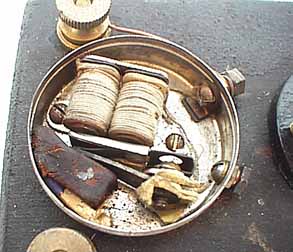
1877a A close view of the pocket watch style
buzzer with cover removed.(23KB)
RESONATORS:
The 'RESONATOR' is a wooden box which channels and
acoustically amplifies the sounds made by a sounder to help
an operator to hear the clicking sounds. The typical resonator is
made of 3/8-inch thick cherry or similar wood.
If you would like to build one, the dimensions are as follows:
The base is 6-7/8 inches wide and 4-7/8 inches deep overall.
The height of both the back wood panel and of the front edge
up to the peak is 7-7/8 inches.
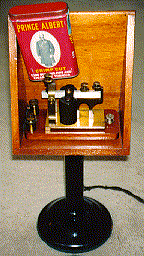
2030 SOUNDER IN CANDLESTICK-BASE RESONATOR:(23KB)
The resonator is mounted on a metal candlestick phone style base.
The sounder is marked MANHATTAN ELEC SUPPLY CO, NEW YORK.
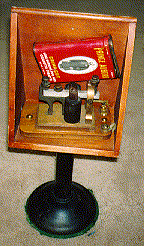
2031 *, 2032 * Same as above:(23KB)
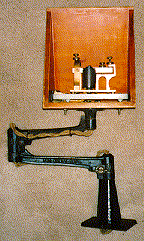
2035 SOUNDER IN SWING-ARM MOUNTED RESONATOR:(20KB)
Resonator is mounted on a two section adjustable cast iron arm with
screw down base. Sounder is Bunnell.
2040 * SOUNDER IN RESONATOR. Resonator is roughly constructed on a wooden
upright base and looks home made. Sounder is Bunnell.

2050 * GEOHEGAN PATENT BUNNELL SOUNDER:(15KB)
This sounder has two special adjustments to allow its sensitivity
to be adjusted so that it could respond to weak incoming signals.
First, there is a cam which is activated by the round brass
wheel on the vertical frame and which adjusts the coil-core to
armiture spacing. Second there is a knob activated adjuster
which allows the spring tension to be adjusted very precisely.
2051 SOUNDER: * Very Large brass sounder on a wooden base. Sounder
engraved "J.H.Bunnell & Co, New York. Patent applied for".
2052 SOUNDER: * Large brass sounder on a wooden base. Sounder engraved
"Patented in U.S.A. March 6, 1917". and "J.H.Bunnell & Co, New York.
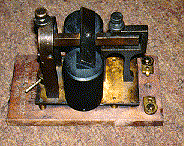
2054 * MAIN LINE SOUNDER:(19KB)
Large brass sounder on a wooden base. Sounder engraved Western
Electric. Base engraved W. U. Tel. Co. Main Line Sounder 3B(?) 20 ohms.
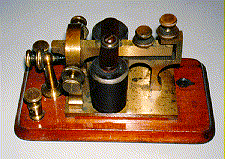
2056 * SOUNDER:(22KB)
This is a very old style medium size brass sounder mounted on a wooden
base stamped 20. The sounder has an interesting horizontal spring and
is engraved J.H.Bunnell & Co, New York.
2058 * SOUNDER: Medium size brass sounder on a black wood base. Base
labeled "Western Electric Company" & stamped "20 ohms" on top &12519(H)
on bottom.
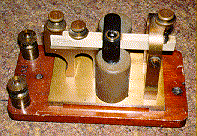
2060 * SOUNDER:(20KB)
Medium size brass sounder on a black wooden base. Sounder engraved
"Western Electric". Base engraved "SOUNDER 3B 20OHMS".
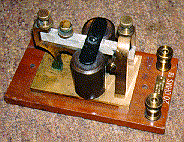
2062 * SOUNDER:(19KB)
Medium size brass sounder. Wooden base.Sounder engraved "Western
Electric".Base labeled "Western Electric Company" and stamped "20
OHMS(H)"
2064 * SOUNDER: Medium size brass sounder on a wooden base. Sounder
engraved "Manhattan Electric Supply Co. New York". Base engraved "20
OHMS".
2066 * SOUNDER: Medium size brass sounder. Wooden base. Sounder engraved
"SIGNAL"

2080 * VERY UNUSUAL SOUNDER:(16KB)
The lever of this sounder is separated from the iron armiture
by an adjustable spring mechanism. The separation distance and
the spring tension can be adjusted by the knob on top
of the sounder.
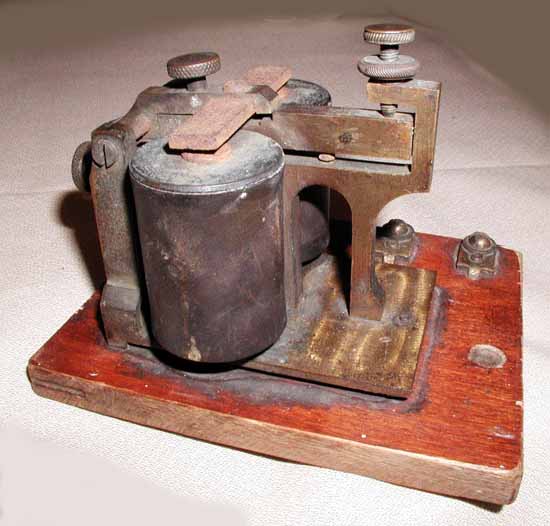
2080a * A closer view of the Unusual
Sounder:(37KB)

2095 * VERY UNUSUAL SOUNDER MECHANISM:(16KB)
This strange sounder looks as though it was made to fit into
some larger wooden structure.

2100 UNFINISHED SOUNDER MECHANISM:(17KB)
This sounder was never assembled nor varnished. It gives us an
idea of what sounders looked like during the assembly process.
2255 * BRITISH GPO SOUNDER: Sounder like the one in the
combination set number 1755. This sounder is mounted
mounted on its own wooden base.
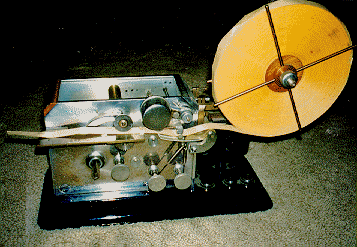
2520 MORSE REGISTER made by FOOTE PIERSON & Co:(45KB)
With chromed case and glass encased brass movement. Spring mechanism
starts when character is received. With roll of original paper tape.
Case stamped FOOTE PIERSON & CO. NEWARK, NJ. F-5570 F-2.
2525 * MORSE REGISTER: as above but with brass case and beveled glass-
encased brass movement. Case stamped FOOTE PIERSON & CO. 160-162 Duane
St., New York. 10243.
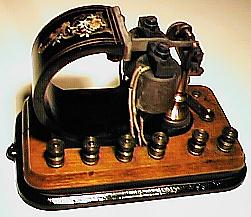
2550 * EARLY BUNNELL CURVED POLAR RELAY:(17KB)
Lovely flowered curved magnet polar relay on large wooden base.
(Traded to John Casale - W2NI.)
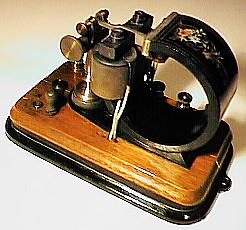
Another view of # 2550(17KB)

2553 * UNUSUAL EARLY BUNNELL RECTANGULAR
POLAR RELAY:(19KB)
This is an unusual rectangular box-shaped polar relay made by
J. H. Bunnell.
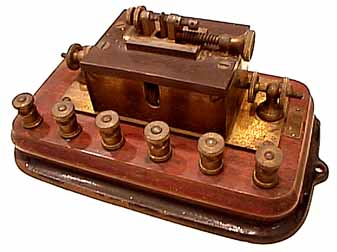
2553a Another view of the Bunnell polar relay:(19KB)
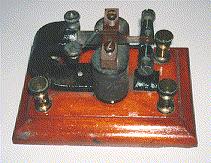
2555 * EARLY CURVED POLAR RELAY:(19KB)
Unique curved frame.Smallish wooden base stamped 60 ohms.>>W2PM

2557 * WESTERN UNION POLAR RELAY:(20KB)
This polar relay was used in duplex and multiplex circuits
which allowed several signals to be carried simultaneously
on the same wires.
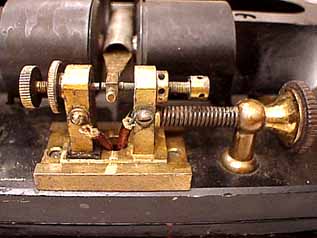
2557a A closer view of the contacts:(19KB)

2558 * JESTER-COOPER REPEATER RELAY:(15KB)
This repeater/relay was used in duplex and multiplex circuits
which allowed several signals to be carried simultaneously
on the same wires. The label reads: J-C Repeater System,
Patent No. 1,116,591. Ohms, 250. Type D. Serial-661. Jester
Cooper Company, Houston, Texas.
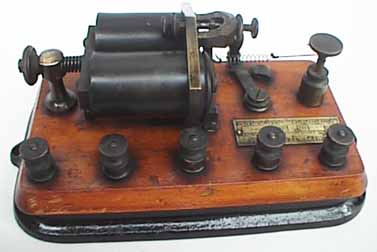
2558a A different view of the repeater:(15KB)
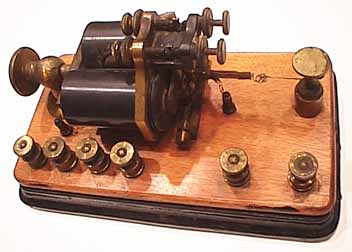
2559 * BUNNELL REPEATER RELAY:(19KB)
This repeater/relay was used in duplex and multiplex circuits
which allowed several signals to be carried simultaneously
on the same wires.
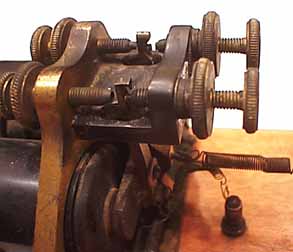
2559a A closer view of the special contacts:(15KB)
2560 * EARLY TELEGRAPH LINE RELAY OF UNUSUAL DESIGN. All brass relay with
unusually large vertical coils with large adjusting screw and odd design
on wooden base on cast iron base.

2562 * UNUSUAL REPEATER RELAY:(16KB)
This small repeater/relay was used in duplex and multiplex circuits
which allowed several signals to be carried simultaneously
on the same wires.
2565 * EARLY TELEGRAPH LINE RELAY OF UNUSUAL DESIGN. Medium size all brass
relay with curved iron armiture and string-spring tensioning. (50 Ohms).
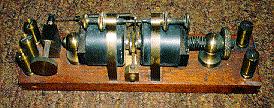
2570 * SMALL POLAR-LIKE TELEGRAPH LINE RELAY:(23KB)
Very unusual small relay with two coils pulling on a shared armiture which
is adjustably tensioned by a spring/string. One coil can be moved toward
and away from the armiture. The wires in the wooden base are sealed in
beeswax. Old cylindrical terminals. * TRADED OUT: 1995.
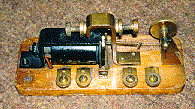
2575 * TELEGRAPH RELAY:(17KB)
Unusual small brass relay on wooden base stamped "MFD by L.F.C., SIGNAL
RELAY 3-D on top and N.Y.R.S.4-29 on bottom.
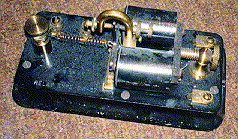
2580 * TELEGRAPH RELAY:(24KB)
Large Brass relay on black bakelite and metal base which is inscribed
"RELAY TYPE SW-37".

2581 * WESTERN UNION 4-D TELEGRAPH RELAY:(18KB)
Large plated relay on black bakelite and metal base which is inscribed
''WU TEL CO. MORSE RELAY 4-D. 100 OHM.''

2582 * WESTERN UNION 22-A TELEGRAPH RELAY:(18KB)
Large plated relay on black bakelite and metal base which is inscribed
''WU 22A''
2585 * TELEGRAPH RELAY: Large Brass relay on wood and metal base which is
inscribed "Signal Electric Co. Menominee, Mich 150 ohms".

2588 LARGE BUNNELL TELEGRAPH RELAY:
Large Brass relay with very large coils mounted on wood and metal base. The
shape of the frame has led people to also refer to this as a 'spectacle relay'
since the coil supports resemble a pair of spectacles. Labeled: J.H.Bunnell
& Co. N.Y. 250 ohms.
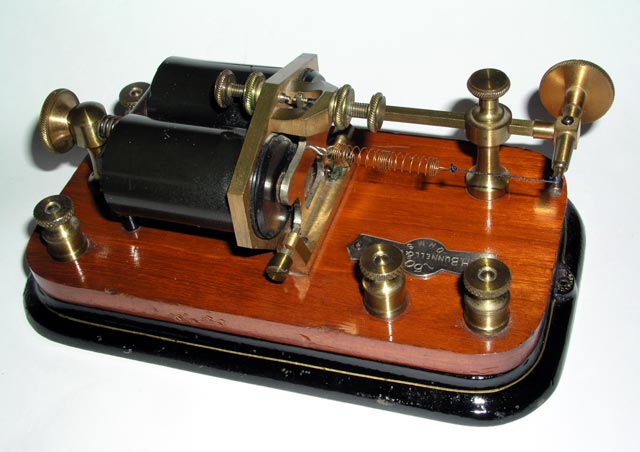
2588a Another view of the Bunnell Telegraph Relay:
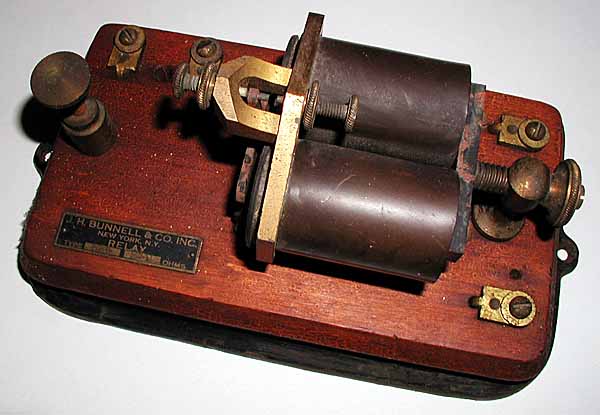
2590 LARGE BUNNELL TELEGRAPH RELAY:(33KB)Large Brass
relay with very large coils mounted on wood and metal base. The shape
of the frame has led people to also refer to this as a 'spectacle
relay' since the coil supports resemble a pair of spectacles.
Labeled: J.H.Bunnell & Co. N.Y. 250 ohms.

2591 LARGE BUNNELL TELEGRAPH RELAY:(35KB)Similar
to above.

2592 MEDIUM SIZE BUNNELL TELEGRAPH RELAY:(33KB)
Medium-size brass relay on wood and metal base with
metal ''bowtie-shaped'' Bunnell label.

2593 SMALL BUNNELL TELEGRAPH RELAY:(19KB)
Small plated brass relay on wood and metal base with
metal ''bowtie-shaped'' Bunnell label.
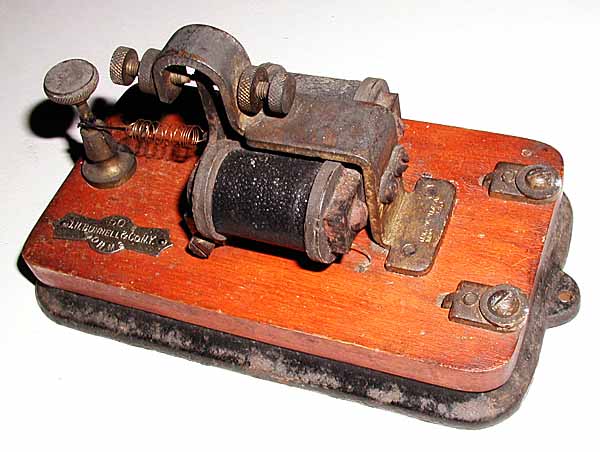
2593a Another view of the
Small Bunnell Telegraph Relay:(46KB)

2594 SMALL BUNNELL TELEGRAPH RELAY: Small plated brass
relay on wood and metal base with metal ''bowtie-shaped'' Bunnell label.
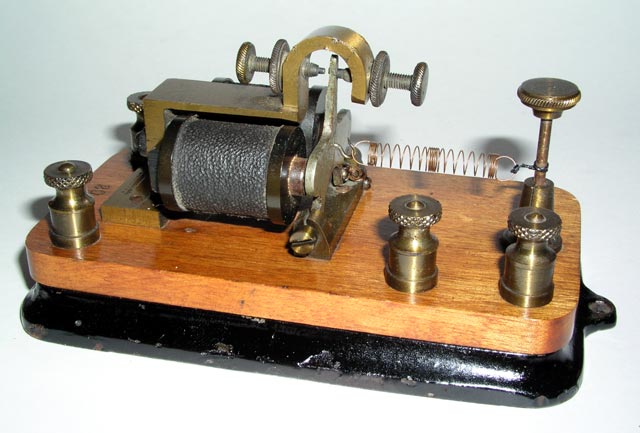
2594a Another view of the Small Bunnell Telegraph
Relay:(46KB)
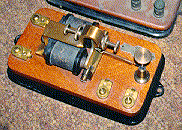
2595 * SMALL BUNNELL TELEGRAPH RELAY:(19KB)
Small Brass relay on wood and metal base which is inscribed "J H Bunnell
& Co. N.Y. 100 ohm".
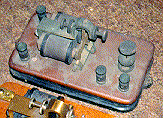
2597 * Same as above but 4 ohm:(15KB)
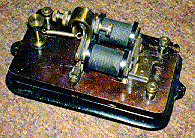
2598 * Same as above but just stamped 20 ohms:(21KB)
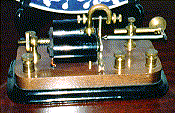
2599 * Same as above but just stamped 20 ohms:(14KB)

2600 * SKIRROW-PATENT POSTAL TELEGRAPH CO.
RELAY:(18KB) An unusual relay with the "Skirrow" patented
rack-and-pinnion adjustment for the coil-to-armiture distance.
Postal Telegraph Co. owned this patent.
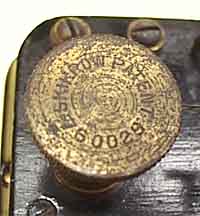
A close-up of the Patent on the tension adjustment
knob:16KB)
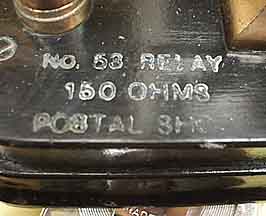
A close-up of the label:(15KB)
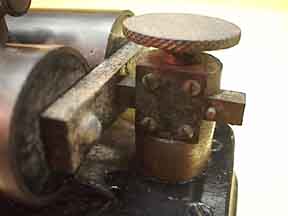
A close-up of the Skirrow mechanism:(10KB)

2605 SMALL PLATED MESCO TELEGRAPH RELAY:(15KB)
This is a small plated brass telegraph relay which was
made by the Manhattan Electric Supply Company (MESCO) It
is labeled under the armiture.
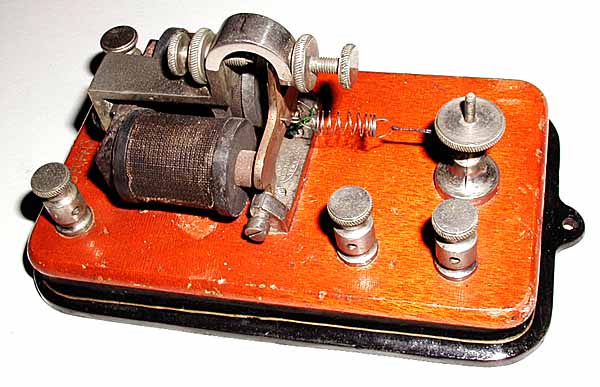
2605a Another view of the
SMALL PLATED MESCO TELEGRAPH RELAY:(47KB)
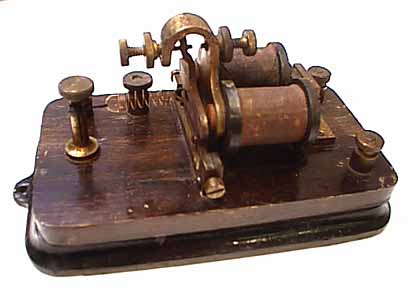
2607 * SMALL SIGNAL ELECTRIC COMPANY
TELEGRAPH RELAY:(15KB)
This is a small relay which was made by Signal Electric
Company. Many thousands of these relays were made and
used and they are very common.

2610 * ASSOCIATED PRESS WHEATSTONE POLAR
TELEGRAPH RELAY:(11KB)This polar relay is housed in
a cylindrical casing with a beveled glass top cover.
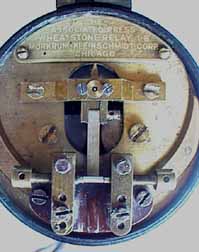
2610a A closer view of the label and
contacts:(15KB)

2630 * VERY SMALL TELEGRAPH RELAY:(15KB)
Very small mostly brass relay on grey marble base.
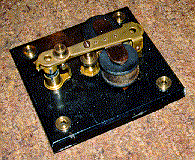
2640 * "SPARK"? TELEGRAPH RELAY:(22KB)
Unusual small brass relay on grey marble base with vertically mounted
coils and 3/8 inch carbon contacts. May have keyed spark transmitter.

2805 WESTERN ELECTRIC BOX SOUNDER / ROD-LEVER
KEY:(31KB)
The key on this early Western Electric combination box sounder and key has
the uniquely Western Electric designed lever made of two parallel
steel rods.
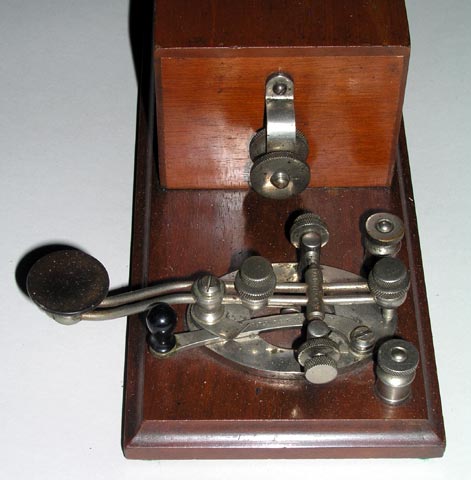
2805a A closer view of the key on the Box Sounder
/ Rod-Lever Key:(34KB)
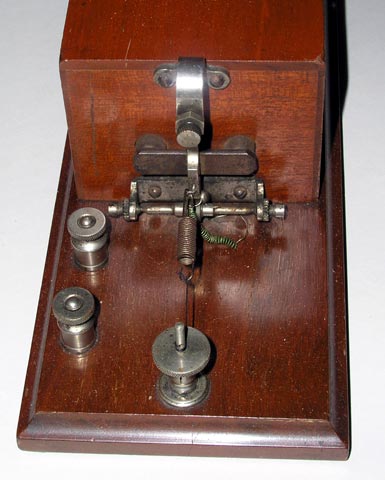
2805b A closer view of the box sounder on the Box
Sounder / Rod-Lever Key:(34KB)
2810 * OLD BUNNELL BOX RELAY/KEY. Key is steel lever style with "patent
applied for" on shorting switch and extremely narrow lever area under
knob. This may be the first model "Triumph Key" made just before the 1881
patent was issued.
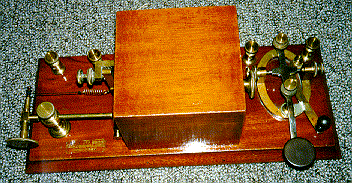
2815 * TELEGRAPH BOX RELAY/SOUNDER AND KEY:(45KB)
Old brass JH Bunnell key with steel lever and brass shorting switch
mounted on wooden base with an all wooden boxed brass combination relay
and sounder. The base has a metal label reading: 150 Ohm.J.H.Bunnell &
Co., N.Y.
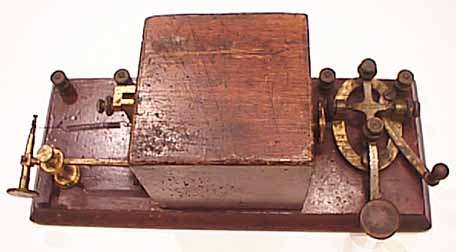
2816 * TELEGRAPH BOX RELAY/SOUNDER AND KEY:(18KB)
Old brass JH Bunnell key with steel lever and brass shorting switch
mounted on wooden base with an all wooden boxed brass combination relay
and sounder. The base has a metal label reading: 150 Ohm.J.H.Bunnell &
Co., N.Y.
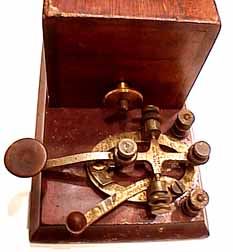
2816a A closer view of the telegraph key:(15KB)
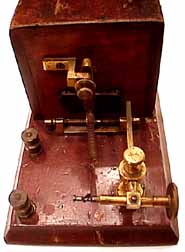
2816b A closer view of the relay/sounder:(13KB)
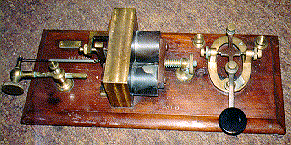
2820 * TELEGRAPH RELAY/SOUNDER AND KEY:(31KB)
Old brass key with steel lever mounted on wooden base with a brass
combination relay and sounder. Labeled: "J.H.Bunnell New York,N.Y.
RELAY, Type 405, 150 ohms.

2822 * TELEGRAPH RELAY/SOUNDER AND KEY:(15KB)
Similar to above.
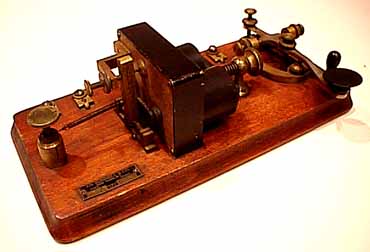
2822a * Another view of # 2822:(17KB)
2824 * Same as above but labeled "Western Electric Company, Pat'd".
2826 * Same as above but labeled "W. U. Tel. Co., Pat'd", 35 ohms.

2825 * UNUSUAL RIGHT-ANGLE KEY AND RELAY SET:(16KB)
This is a very unusual combination of a right-angle telegraph key
and a sensitive relay mounted on a thick bakelite base with
contact pins sticking down to make contact with some kind of sub-base.
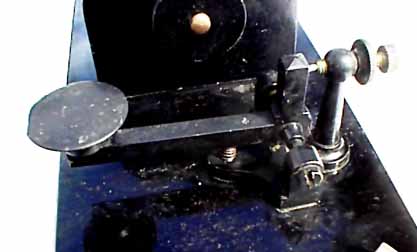
2825a A closer view of the telegraph key:(15KB)
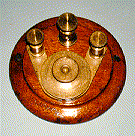
2930 * TELEGRAPH LINE LIGHTNING ARRESTOR:(12KB)
Lovely brass mechanism on round wooden base. Lightning spark gap can be
adjusted by turning large brass wheel.
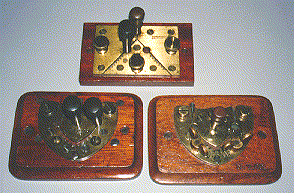
2932 * TELEGRAPH LINE LIGHTNING ARRESTOR:(32KB)
Lovely brass mechanism on rectangular wooden base. Lightning spark gap
is the double sawtooth design. Brass pins can be inserted to ground
various lines.Engraved J.H.Bunnell & Co.NewYork.
2934 Similar to above engraved L.G.TILLOTSON, 8 Dey St. New York.
2936 * TELEGRAPH LINE LIGHTNING ARRESTOR. Lovely brass mechanism on
rectangular wooden base. Lightning spark gap is the double sawtooth
design and a brass pin can be inserted to ground various lines. Brass
wing nuts are used to connect to the lines. The wood base is engraved
N.T. CO. Which probably stands for National Telephone Company the competitor
to the British Post Office until nationalized in 1912.

2940 * SWISS TELEGRAPH TEST SET:(17KB)
This is an unusual Swiss Telegraph Test Set.

2950 * WESTERN UNION - BUNNELL 18-A TELEGRAPH
RHEOSTAT NETWORK:(19KB)
This is a network of switchable resistors which can be switched into
a circuit to help balance it.

2950a A closer view of the label of the
rheostat:(22KB)
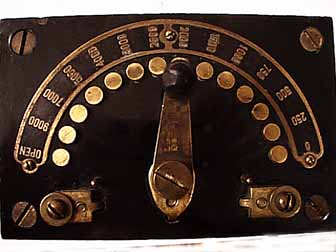
2950b A closer view of the dial of the
rheostat:(22KB)
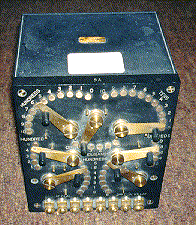
2960 TELEGRAPH LINE IMPEDANCE MATCHING NETWORK:(29KB)
Black box marked Western Electric with many brass switches for selecting
combinations of capacitors and resistors to simulate a second line for
duplex setups and to balance line impedance over very long distance
lines.

2968 BRITISH GPO TELEGRAPH TEST METER SET:(18KB)
This set consists of a multimeter with many voltage ranges which
is marked GPO and accompanied by numerous shunts to increase
the ranges.
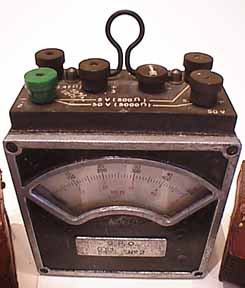
2968a A closer view of the meter:(16KB)
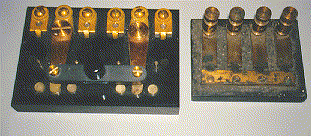
2970 * TELEGRAPH LINE SWITCH:(23KB)
2-pole,3 position sliding line switch mfg by Bunnell.
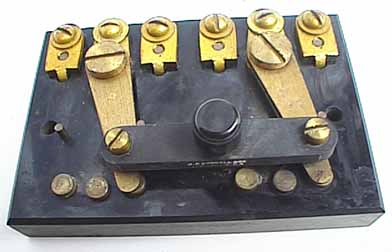
2970a Another view of the switch:(18KB)
2972, 2974 * Similar to above but use brass pins (missing) to make the
contacts.

2972 * TELEGRAPH LINE SWITCH:(23KB)
This is a 4-pole, 2 position telegraph line switch.
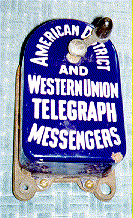
2980 * WESTERN UNION TELEGRAPH CALL BOX:(17KB)
When you turned the handle of this box it sent out a coded call and
dispatch a messenger to your location to pick up a telegram.
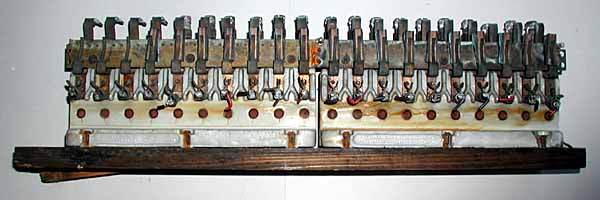
2985 20-LINE TELEGRAPH OFFICE INPUT PANEL:(26KB)
This is the input panel for 20 telegraph lines coming into a
telegraph office. It has a separate fuse for each line and a jack
for connecting the office instruments to each line. It is labeled:
Western Union Telegraph Company.
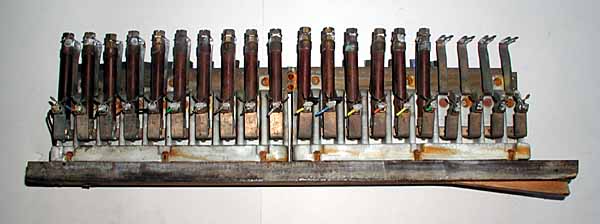
2985a The other side of the
panel:(29KB)
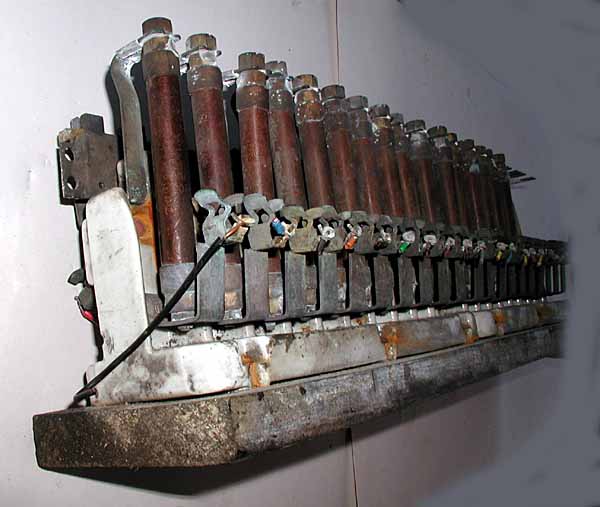
2985b Another view of the
panel:(35KB)
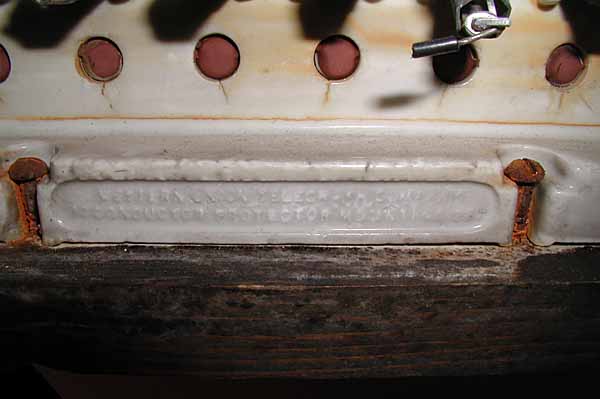
2985c A close-up view of the
label:(24KB)
Keys used in Fire Departments and Fire Alarm Circuits:
2990 * FIRE ALARM KEY & LIGHTNING ARRESTOR:(15KB)
Many interesting and early keys were used in early fire-alarm systems in which
the location of the fire was transmitted as a series of short electrical
pulses and long or short spaces. The signals were received as a series of
bell rings in every fire house in the city. Fire alarm keys such as this one
are often mistaken for telegraph keys. In trying to determine whether a key
is from a fire-alarm or telegraph system, it is helpful to remember that
Gamewell and Roland made exclusively fire alarm apparatus. In addition, the
keys do not usually have fine adjustments and are designed for rather large
movements of the knob. Many, such as this one do not even have any adjustment
for knob-travel or spring tension.
2995 UNUSUAL ANGLED FIRE ALARM KEY:(15KB)
This unusual upward-angled key was mounted vertically on a Fire Alarm Bureau
test panel. Keys like this were used in test circuits in the Fire Alarm
Bureaus of major city Fire Departments like that in Boston. In the early days
before telephone and radio, these keys were sometimes also used to send Morse
Code messages between the Alarm Bureau Staff and the Linemen that were working
to maintain the circuits.
In rare emergencies involving the breakdown of the Chief Dispatcher's desk
equipment, these test board keys were used to send actual fire alarm signals
on local and city-wide fire alarm circuits.
The Chief Dispatcher's key was referred to as a "tapper". The coded
location of the fire was sent by the "tapper" and received in the form of bell
signals at the remote stations. Every 'tap' on the key would ring alarm bells
in all the fire statgions in the city to identify the location of the
fire.
These keys were widely used in fire stations as early as the 1860's (This key
is much more recent).
2995a A view of the contacts of the Fire Alarm
Key:(15KB)
2998 CAMELBACK STYLE FIRE ALARM KEY:(33KB)
This Chrome-plated camelback key was probably used by a Chief Dispatcher
because it is horizontally-oriented. Chief Dispatcherts used this type of key
to send fire alarm signals on local and city-wide fire alarm circuits. Often
mistaken for land-line telegraph keys, these fire alarm keys (sometimes called
'tappers') were widely used in fire stations as early as the 1860's (This key
is much more recent). The coded location of the fire was sent by the key and
received in the form of bell signals at the remote fire stations.
CONTACT INFORMATION
Please Note: IF YOU DO NOT RECEIVE AN ANSWER TO YOUR EMAIL
IT MEANS THAT I CAN NO LONGER RESPOND.
Please use internet search engines to find other information if you do not receive a reply.
Professor Tom Perera
Ph. D. - W1TP
Professor Emeritus:
Montclair State University
Go to Tom Perera's Professional Neuropsychology Home Page.
- Email Address:
(To help me avoid automated 'junk mail' programs,
I ask you to type my email address as
follows with no spaces between words:)
- PLEASE TYPE: keys
- THEN TYPE THE @ SYMBOL
- THEN TYPE: w1tp.com
- Please NOTE: { it is w1tp - W then the NUMERAL "1" (one) then tp }...
(It is NOT wLtp or wItp).
- Please NOTE: IF YOU DO NOT RECEIVE AN ANSWER TO YOUR EMAIL IT MEANS THAT I CAN NO LONGER RESPOND.
Please use internet search engines to find other information if you do not receive a reply.
- Please NOTE: You MUST include the word
KEYS in the Email Subject Line.
- Please Sign your email.
IF you do not receive a reply my spam cleaner might have intercepted your
email.
Pease try again with a different Subject and Text.
- ( Please Enquire Before Sending Attachments Larger Than 1MB - Thank
you.)
Internet On-Line Telegraph & Scientific Instrument Museums:
http://w1tp.com
Internet ENIGMA Museum:
https://EnigmaMuseum.com
COPYRIGHT NOTICE: (Copyright (c) 2023: Prof. Tom Perera Ph. D.)
Although all the pictures and text are copyrighted, you may use any of them
for your own personal applications including public lectures and
demonstrations, publications and websites as long as you mention the
w1tp.com Museum. If you plan to offer them for sale to the public
in any form, please email me for permission which I will generally grant as
long as you mention my museum: http://w1tp.com or https://EnigmaMuseum.com My email address is
given at the bottom of this page. Some of the material may require contacting
other copyright owners for commercial use and I will inform you by email.
Please also see the Disclaimer of Warranty.























































































































































